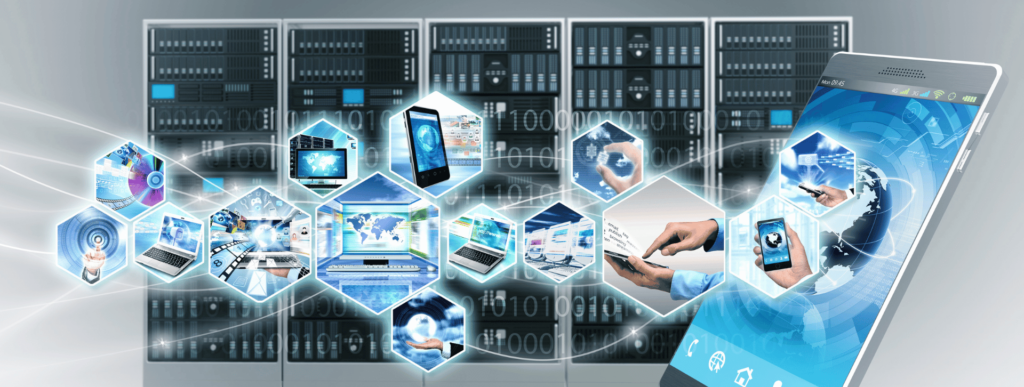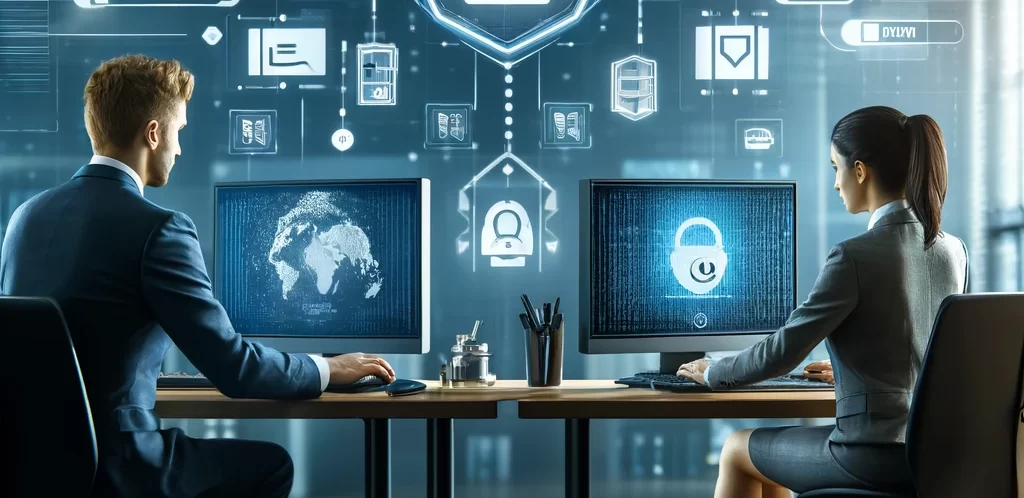Cybersecurity Tips and Best Practices for Your Business
Learn about managed SIEM, secure file sharing, VPNs, and more to safeguard your company’s digital assets.
Table of Contents
In today’s digital landscape, cybersecurity is paramount for any business. This guide will outline 21 essential tips and best practices to bolster your company’s cyber defences. By adhering to these guidelines, businesses can effectively mitigate risks and protect their digital assets.

1. Keeping Software Up-to-Date: A First Line of Defense
Consistently Update to Seal Security Gaps
Maintaining the currency of your software is a foundational element of robust cybersecurity. Regular updates are not merely enhancements but crucial defenses against the ever-evolving threats that target older software systems.
Each update can include patches for security vulnerabilities that have been recently uncovered and fixing flaws that cybercriminals could exploit to gain unauthorized access to your systems.
The Importance of Timely Updates
When software remains outdated, it becomes a fertile ground for cybercriminals. These individuals or groups are always on the lookout for systems that lag behind in security patches because they are easier to breach.
By exploiting known vulnerabilities, hackers can install malware, steal sensitive information, or gain control over your business’s entire IT infrastructure.
The Role of Managed SIEM in Update Management
In addition to general software update management, managed SIEM (Security Information and Event Management) services can provide an extra layer of security.
These services help by continuously monitoring and analyzing the event logs generated by all devices within the network. These logs can indicate anomalies that suggest the need for specific software updates.
For example, if a new type of threat is detected, managed SIEM can help identify which systems are affected and promptly ensure that these systems receive the necessary patches.
2. Email Vigilance: Avoid Opening Suspicious Emails

Identifying and Dodging Cyber Threats
Phishing attacks, one of the most prevalent methods cybercriminals use, typically begin with an innocent-looking email that can lead to significant security breaches if not appropriately handled.
The sophistication of these attacks has grown, making it increasingly difficult to distinguish malicious emails from legitimate ones. However, with vigilant practices and the right tools, businesses can protect themselves effectively.
Recognizing the Hallmarks of Phishing Emails
Education is the first line of defense against phishing attacks. Employees should be trained to spot the telltale signs of phishing attempts.
This includes scrutinizing the sender’s email address for slight anomalies that might suggest forgery, such as misspellings or incorrect domains that mimic legitimate addresses closely but are not the same.
Other red flags include unsolicited attachments or links, emails demanding urgent action, and messages containing poor grammar or formatting.
Implementing Robust Email Filters and Security Policies
To further enhance security, organizations should implement robust email filtering systems.
These systems can block emails from known malicious sources and flag emails that contain known malware signatures or suspicious payloads.
Additionally, maintaining and regularly updating a whitelist of approved senders can help minimize the chances of phishing emails reaching employee inboxes.
Regularly Updating Anti-Phishing Tactics
Cyber threats evolve rapidly, making it crucial to keep anti-phishing tactics up-to-date. This involves regular training refreshers for all staff to familiarize them with the latest phishing techniques and preventive measures.
Organizations should also conduct simulated phishing exercises to test employee readiness and adjust training programs based on the outcomes.
3. Hardware Integrity: Keep Hardware Up-to-Date

Ensuring Physical Components Aren't the Weak Link
In cybersecurity, the emphasis often leans heavily on software solutions; however, maintaining the integrity of physical hardware is equally essential. Up-to-date hardware is crucial for securing your business against advanced cyber threats, which are increasingly capable of exploiting even minor hardware vulnerabilities.
The Risks of Outdated Hardware
Outdated hardware struggles to run newer software efficiently and often lacks the latest security features that new hardware brings.
Older systems may not support modern encryption standards or advanced security protocols, exposing your network to intrusions.
Furthermore, manufacturers often cease support for older models, including critical security updates, leaving your systems vulnerable to newly discovered threats.
Upgrading Hardware Strategically
When upgrading hardware, it’s essential to do so strategically.
This involves assessing which pieces of hardware are crucial for your day-to-day operations and which might pose the most significant risk if compromised.
Prioritizing the security of servers, routers, and other network infrastructure can prevent widespread security breaches that could originate from these critical points.
Employee Training on Hardware Security
In addition to technical upgrades and audits, educating your employees about hardware security is crucial.
This includes training them to recognize the signs of potential hardware tampering or failure.
Employees should also be aware of the proper handling and usage of company hardware to avoid physical damage or misuse, which could inadvertently lead to security vulnerabilities.
4. Secure File Sharing: Utilize Encryption

Protecting Data in Transit and at Rest
In the digital age, the ability to share information rapidly and securely is a cornerstone of business operations.
Utilizing secure file-sharing solutions with end-to-end encryption is essential for protecting sensitive data in transit and stored on servers. Additional encryption techniques can also be utilized to secure your digital assets further
This level of security is crucial in maintaining the confidentiality and integrity of business data, ensuring it remains out of the reach of unauthorized individuals.
The Importance of End-to-End Encryption
End-to-end encryption (E2EE) is a secure communication method that prevents third parties from accessing data while it’s transferred from one end system or device to another.
In file sharing, the data is encrypted on the sender’s device and only decrypted on the recipient’s device, with no intermediary (including the service provider) accessing the readable content.
This method ensures that sensitive information such as financial records, personal employee data, or proprietary business information is securely encrypted throughout its online journey.
Benefits of Secure File Sharing Systems
Using a secure file-sharing system provides several benefits:
- Data Integrity: Ensures that the data being sent is not altered during transit.
- Confidentiality: Keeps sensitive information private and accessible only to intended recipients.
- Compliance: Helps businesses meet legal and regulatory requirements concerning data security.
- User Authentication: Often includes features that verify the identity of users accessing the system, adding an additional layer of security.
Implementing Secure File Sharing in Business Processes
Integrating secure file-sharing practices into your business processes involves more than just selecting the right tool.
It requires setting up proper access controls and user permissions to ensure that only authorized individuals can share and access files.
It is also crucial to train employees to use these tools effectively and safely. They should understand the importance of security measures and how to handle data responsibly.
Regular Audits and Updates
Another key step in ensuring the security of your data is regularly auditing and updating the security measures of your file-sharing systems as needed. This includes reviewing who has access to what data and making sure that outdated accounts or permissions are promptly modified or revoked.
5. Antivirus and Anti-Malware Protection
Building a Resilient Defenee Against Malware
In today’s interconnected world, malware poses one of the most significant threats to individual and organizational cybersecurity.
Implementing robust antivirus and anti-malware solutions is critical to defending your systems against these malicious programs.
These solutions are essential tools for identifying, thwarting, and eliminating malware before it can inflict harm.
The Role of Antivirus and Anti-Malware Software
Antivirus and anti-malware software are designed to scan for, detect, and remove viruses and other malicious software from computers and networks.
These programs continuously monitor your system to prevent, detect, and remove malware that can compromise data integrity, steal sensitive information, or cripple your IT infrastructure.
The software typically uses a combination of signature-based detection, which identifies known malware; heuristic-based detection, which spots suspicious behavior; and behavior-based detection, which identifies anomalies within the system.
Importance of Keeping Protection Active and Updated
It is crucial that antivirus and anti-malware software remain active and are regularly updated to ensure their effectiveness.
Cybercriminals are constantly developing new strains of malware designed to evade older, outdated security software.
Regular updates ensure that your protective software can recognize and combat the latest threats by updating its database of virus and malware definitions.
Scheduled Scans and Real-Time Protection
Beyond regular updates, setting up scheduled scans is essential to maintain system health. These scans can help catch any threats that might have slipped past real-time protection measures.
Real-time protection, however, is crucial as it provides immediate defense against threats as they occur, blocking malicious programs and files from being downloaded or run on your system.
Integration with Other Security Measures
While antivirus and anti-malware solutions are critical, they should not be your only line of defense.
These solutions work best when integrated with other security measures such as firewalls, intrusion detection systems, and data encryption.
This layered approach to security can provide a more comprehensive defense against various cyber threats.
6. VPN Usage: Privatizing Your Connections
Securing Internet Connections Even Outside the Office
In an era where remote work and mobile access are commonplace, securing the connections through which your employees access company resources is crucial.
A Virtual Private Network (VPN) is essential for protecting these connections by encrypting data traffic and masking IP addresses, ensuring that sensitive business data remains confidential and secure, even when accessed from less secure, public internet connections.
Understanding VPN and Its Importance
A VPN creates a private network from a public internet connection, providing privacy and anonymity by making a secure and encrypted connection.
This tunnel shields your internet activity from cyber threats, eavesdropping, and interceptions, which is especially critical when employees use public Wi-Fi networks, such as coffee shops, airports, or hotels.
How VPN Works
When a VPN is activated, it routes your device’s internet connection through the VPN provider’s server rather than your internet service provider (ISP).
As a result, the data transmitted to the internet comes from the VPN rather than your computer.
This encrypts your data and hides your IP address, making it much harder for third parties to track your activities or determine your geographical location.
Benefits of Using a VPN
- Enhanced Security: By encrypting data, a VPN prevents unauthorized access to transmitted information, which is particularly important when handling sensitive or confidential company data.
- Remote Access: VPNs enable employees to securely access the company’s network from anywhere, making it easier for remote workers to interact with resources they need while ensuring that this access does not compromise security.
- Anonymity: VPNs offer anonymity while browsing the web, as they mask user IP addresses. This feature is beneficial for protecting personal and business privacy.
- Bypass Filters and Censorship: VPNs can also bypass internet filters and censorship by allowing users to connect from a server located in a different geographic location, which can be pivotal for businesses operating in areas with restricted internet access.
Implementing VPN in Business Operations
Implementing a VPN solution involves several key steps:
- Choosing the Right VPN Provider: Select a VPN provider known for strong security features, reliable performance, and good customer support. Consider providers that offer multiple server locations, robust encryption methods, and no-log policies.
- Setting Up VPN Access: Configure VPN access for all employee devices that need to access the company network remotely. Your IT team should guide this setup to ensure it aligns with other network security measures.
- Training Employees: Train employees on how to use the VPN correctly and explain the importance of constantly activating the VPN when using public networks. This training should also cover the potential risks of non-compliance.
Integrating VPN with Other Security Measures
To maximize security, VPN use should be integrated with other security measures such as firewalls, antivirus programs, and multi-factor authentication.
This layered security approach helps protect against various cyber threats and enhances the overall security of the business’s IT infrastructure.
7. Link Safety: Think Before You Click
Preventing Click-Baiting and Spoofing Attacks
Navigating the internet safely requires vigilance, especially when clicking on links.
Cybercriminals commonly use malicious links to deploy malware, steal sensitive information, or gain unauthorized access to user systems.
Ensuring the safety of links before clicking on them is a crucial step in protecting your digital environment against these threats.
Understanding Malicious Links
Malicious links can appear in emails, messages, social media posts, or websites. They often look legitimate but lead to harmful websites or directly initiate malware downloads.
Clicking on a malicious link can inflict severe damage, from compromising personal and financial information to infecting your network with ransomware.
Verifying URL Authenticity
Before clicking on any link, it’s essential to verify its authenticity.
Hover over the link to see the URL in the bottom corner of your browser – this can help you spot discrepancies and recognize fake or malicious websites.
Be wary of URLs that contain misspellings of well-known websites or use uncommon top-level domains.
The Role of Managed SIEM in Enhancing Link Safety
Managed Security Information and Event Management (SIEM) services play a vital role in link safety by providing advanced monitoring and security capabilities.
These systems can analyze and correlate data across the network to identify potential threats, including suspicious link activity.
Managed SIEM solutions can automatically block access to known malicious sites, significantly reducing the risk of a security breach.
Implementing Safe Browsing Practices
In addition to relying on technological solutions, implementing safe browsing practices is vital:
- Educate employees on the risks associated with malicious links and the importance of verifying URLs.
- Use reputable antivirus and internet security software that includes link-scanning features.
- Update your browser and security software regularly to protect against the latest threats.
- Enable enhanced security features in your browser, such as pop-up blockers and fraud detection, which can help prevent spoofing and click-baiting.
Regular Security Training and Simulations
Regular security awareness training and simulations can further enhance your team’s ability to recognize and avoid malicious links.
These training sessions should include examples of recent phishing campaigns and practical tips on link verification.
Simulated phishing exercises can efficiently reinforce these practices by giving employees hands-on experience identifying suspicious links in a controlled environment.
Leveraging Advanced Threat Detection Technologies
For additional security, consider leveraging advanced threat detection technologies such as URL filtering, which blocks users from accessing malicious sites based on databases of known bad URLs, and DNS security solutions, which prevent connections to harmful domains.
These technologies can provide an added layer of security by intercepting malicious traffic before it reaches the user.
8. Password Hygiene: Avoid Common Mistakes
Strong, Unique Passwords Are Non-negotiable
Maintaining rigorous password hygiene is crucial for securing access to digital resources and protecting sensitive data.
Encouraging strong, unique passwords for each account or service is fundamental in preventing unauthorized access.
Here, we delve into why password strength and uniqueness matter and how tools like password managers can assist in maintaining secure password practices.
The Importance of Strong, Unique Passwords
Using strong, unique passwords is one of the simplest yet most effective ways to enhance security.
Strong passwords—long, random, and containing a mix of characters (letters, numbers, and symbols)—are much more complicated for attackers to crack through brute force methods.
Additionally, using a unique password for each service prevents a single data breach from compromising multiple accounts.
Common Password Mistakes to Avoid
Many users reuse passwords across multiple sites or choose passwords that are easy to remember, such as everyday phrases, predictable patterns, or personal information. These practices are insecure:
- Reusing passwords increases the risk that a breach on one site will lead to breaches on others.
- Common words and phrases make passwords vulnerable to dictionary attacks.
- Predictable patterns, such as sequences or repeated characters, can be easily guessed.
Utilizing Password Managers
Password managers are critical tools in maintaining password security. They help by:
- Generating strong passwords: Password managers can create complex passwords that are difficult to crack but also unique to each account.
- Storing passwords securely: Instead of remembering every password, users need to remember only one master password. The password manager encrypts and stores other passwords securely.
- Filling in passwords automatically: Password managers can auto-fill passwords in login forms, reducing the temptation to use simpler, memorable passwords that are less secure.
Best Practices for Password Creation and Management
To further strengthen password security, consider implementing the following best practices:
- Use longer passwords: Aim for passwords that are at least 12-16 characters long.
- Avoid personal information: Do not use passwords that could be easily guessed by someone who knows you or could look up information about you, such as birthdates or pet names.
- Enable two-factor authentication (2FA): Where possible, use 2FA to add an additional layer of security, requiring not only a password but also a second factor, such as a text message code or authentication app, to access an account.
Periodic Password Updates and Audits
While frequent password changes have fallen out of favor as a security recommendation, periodic updates in response to potential or actual security breaches remain vital.
Regular audits of password practices across the organization can help identify weak passwords and ensure compliance with security policies.
Businesses can significantly bolster their cybersecurity defenses by promoting the use of strong, unique passwords and supporting these efforts with tools like password managers and educational programs.
This approach protects against the risks of unauthorized access and reinforces a culture of security within the organization.
9. Bluetooth Security: Disable When Not in Use
Minimizing Wireless Vulnerabilities
Bluetooth technology, while incredibly useful for connecting devices wirelessly, can also present significant security risks if not managed properly.
It offers a potential entry point for security breaches, making it imperative that users exercise caution and take preventive measures to secure their devices.
Understanding Bluetooth Security Risks
Attackers can exploit Bluetooth connections to gain unauthorized access to devices.
This can happen through various methods, such as bluejacking, which involves sending unsolicited messages to a Bluetooth-enabled device; bluesnarfing, where attackers gain access to information on the device; and BlueBorne attacks, which allow attackers to take complete control over the device without requiring pairing.
Such vulnerabilities can compromise personal and corporate data, especially if devices are connected in public or insecure environments.
The Safest Practice: Disabling Bluetooth
Disabling Bluetooth when it is not in use is the simplest and most effective way to prevent such attacks.
This practice reduces the attack surface, ensuring the Bluetooth connection is not an open door for cyber attackers. Disabling Bluetooth protects the individual device and helps secure the broader network environment, especially in organizational settings.
10. Two-Factor Authentication: An Additional Security Layer
Enhancing Account Security
Two-factor authentication (2FA) is an essential security measure that adds a significant layer of protection to the traditional username and password system.
By requiring two distinct verification forms, 2FA ensures that even if one factor (like a password) is compromised, unauthorized users are still prevented from gaining access to accounts.
This dual-layer security is critical in an era where digital security threats are increasingly sophisticated and common.
How Two-Factor Authentication Works
Two-factor authentication involves two different types of credentials. The first layer is typically something the user knows, such as a password or PIN.
The second layer requires something the user has, such as a physical token.
This smartphone app generates a one-time passcode or a biometric factor like a fingerprint or facial recognition. This combination makes unauthorized access to accounts much more difficult for cyber attackers.
The Importance of Implementing 2FA
Implementing 2FA can significantly enhance the security of both individual and corporate accounts:
- Reduces the risk of phishing attacks: Even if attackers can deceive users into providing their password, they would still require the second factor to gain account access.
- Protects against password theft: In cases where passwords are stolen through data breaches or malware, 2FA provides an additional security layer that helps keep accounts safe.
- Secures sensitive transactions: For transactions involving sensitive data or financial activities, 2FA can provide an extra security layer that assures both parties of the transaction’s integrity.
Types of Two-Factor Authentication
There are several forms of 2FA, each with its own advantages and use cases:
- SMS and Email Codes: The system sends a code to the user’s phone or email, which they must enter to proceed. While convenient, this method can be vulnerable to interception or SIM card swapping.
- Authenticator Apps: Applications like Google Authenticator or Authy generate time-limited codes. These are more secure than SMS because they are not transmitted over the network.
- Physical Tokens: Hardware devices like YubiKey can generate or store authentication codes. They are highly secure since they must be physically present to be used.
- Biometric Verification: Fingerprints, facial recognition, or retinal scans provide a high-security level and are extremely difficult to replicate or steal.
Challenges and Considerations
While 2FA dramatically enhances security, it also introduces new challenges:
- User inconvenience: Some users might find switching between devices or apps inconvenient.
- Recovery and access issues: Losing access to the second factor can lock users out of their accounts, so providing a secure yet user-friendly account recovery process is crucial.
By incorporating two-factor authentication into their security framework, businesses and individuals significantly improve their defenses against cyber threats.
This added layer of security protects sensitive data and builds trust with customers and partners who see that security is taken seriously.
Why Partner with Altoverra?
Reduce Threat Impact
Our vigilant monitoring and rapid response ensure that potential threats are detected and neutralized before they can escalate, safeguarding your digital landscape with unparalleled efficiency.
Support Compliance Needs
Achieve standard compliance effortlessly. Our solution ensures that your systems are aligned with industry regulations, guaranteeing a secure environment that meets the highest standards.
100% Hassle-Free
Say goodbye to the complexities of security management. From proactive threat hunting to expertly managed detection, and beyond – we’ve got your security challenges covered.
Elevate Your Security
Step into a realm where cybersecurity is not just a shield—it’s a cornerstone of growth. Join Altoverra’s mission to secure the digital landscape, ensuring your business thrives without compromise.
